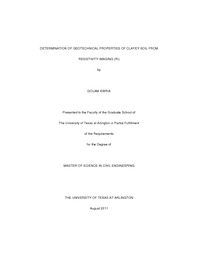
ATTENTION: The works hosted here are being migrated to a new repository that will consolidate resources, improve discoverability, and better show UTA's research impact on the global community. We will update authors as the migration progresses. Please see MavMatrix for more information.
Show simple item record
| dc.contributor.author | Kibria, Golam | en_US |
| dc.date.accessioned | 2011-10-11T20:48:11Z | |
| dc.date.available | 2011-10-11T20:48:11Z | |
| dc.date.issued | 2011-10-11 | |
| dc.date.submitted | January 2011 | en_US |
| dc.identifier.other | DISS-11270 | en_US |
| dc.identifier.uri | http://hdl.handle.net/10106/6144 | |
| dc.description.abstract | The use of resistivity imaging (RI) in the subsurface investigation has increased in recent years. RI is a non destructive method and provides a continuous image of the subsurface. Based on the electrical conduction phenomenon of soil, spatial and temporal moisture variation and he-terogeneity of subsurface can be evaluated from RI. However, only qualitative evaluation of sub-surface can be obtained from RI. The correlation between RI results and geotechnical engineering properties of soils has become an important issue for rigorous use of this method in site in-vestigation. The current study attempts to develop the relationship and correlations between geo-technical parameters with electrical resistivity of soil. These correlations can be used for deter-mining geotechnical properties from RI. Soil samples collected for the current study mostly con-sisted of medium to high plasticity clay with plasticity index more than 30. High energy X-Ray fluorescence (XRF) and scanning electron microscope (SEM) image analysis showed that the dominant clay mineral in the soil samples might be montmorillonite. The effects of moisture content, unit weight, degree of saturation, specific surface area, pore space, ion composition, compaction condition and fine fraction on soil resistivity were determined. Test results showed that soil resistivity decreased with the average rate of 13.8 Ohm-m for the increase of moisture from 10% to 20% at fixed unit weight. However, soil resistivity ranged from 2.1 to 2.42 ohm-m at 50% moisture content. Enhanced interaction between the clay particles and water and occurrence of ionic conduction reduced electrical resistivity with the increase of moisture content. Test results also indicated that soil resistivity decreased almost linearly with an average rate of 0.3 Ohm-m/pcf between moist unit weight 88.5 to 100 pcf at 18% moisture content. The average rate of reduction was 0.08 Ohm-m/pcf for fur-ther increase in moist unit weight in same moisture content. Reduction of interclod pores and better particle-to-particle contact might cause reduction in soil resistivity with the increase of unit weight. However, soil resistivity was more sensitive to moisture content than unit weight. In addi-tion, average resistivity of the samples decreased from 6.7 to 3.2 Ohm-m with the increase of degree of saturation from 40% to 90% due to elimination of interclod macro pores, reorientation of clay particle and remolding of clay. Soil resistivity increased from 4.3 to 14.2 Ohm-m with the increase of specific surface area from 69.6 to 107.1 m2/gm at 18% moisture content and 75 pcf dry unit weight. Lack of for-mation of water film around the soil particle might restrict the current flow. Moreover, soil resistivity increased from 4.4 to 14.2 Ohm-m for the increase of pore space from 1.91% to 10.56% at 18% moisture content and 75 pcf dry unit weight and then decreased. Test results showed that soil resistivity increased from 4.3 to 14.2 Ohm-m with the increase of calcium ion from 8.3% to 13.9% at 18% moisture content and 75 pcf dry unit weight. Observed soil resistivity was high when samples were compacted at dry of optimum be-cause of less pronounce bridging between soil particles. However, soil resistivity decreased when samples were compacted at wet of optimum. Near saturated voids and better interparticle bridging might caused the reduction in resistivity. Correlation of resistivity with unconfined shear strength of soil showed that soil samples prepared with moisture content below optimum, resistivity was high and strength was low. However, both resistivity and strength was low at moisture condition above optimum condition. In addition, soil resistivity were in between 3.16 to 3.6 Ohm-m for the increase of fine fraction from 66% to 94.8%. Therefore, the observed variation in soil resistivity with the fine content was not significant. Based on the study, it can be summarized that geotechnical engineering properties can be determined from RI under certain site specific conditions and moisture is the most influencing factor in electrical conduction. | en_US |
| dc.description.sponsorship | Hossain, Sahadat | en_US |
| dc.language.iso | en | en_US |
| dc.publisher | Civil & Environmental Engineering | en_US |
| dc.title | Determination Of Geotechnical Properties Of Clayey Soil From Resistivity Imaging (RI) | en_US |
| dc.type | M.Engr. | en_US |
| dc.contributor.committeeChair | Hossain, Sahadat | en_US |
| dc.degree.department | Civil & Environmental Engineering | en_US |
| dc.degree.discipline | Civil & Environmental Engineering | en_US |
| dc.degree.grantor | University of Texas at Arlington | en_US |
| dc.degree.level | masters | en_US |
| dc.degree.name | M.Engr. | en_US |
Files in this item
- Name:
- Kibria_uta_2502M_11270.pdf
- Size:
- 3.323Mb
- Format:
- PDF
This item appears in the following Collection(s)
Show simple item record


